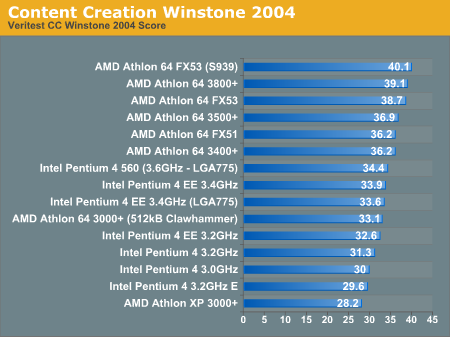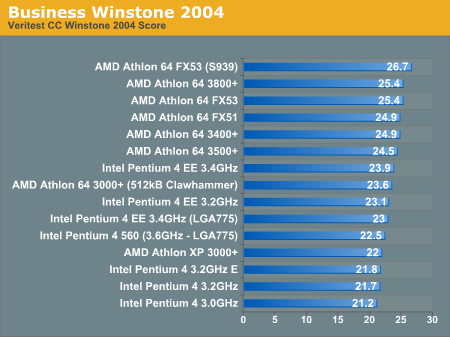Intel's 925X & LGA-775: Are Prescott 3.6 and PCI Express Graphics any Faster?
by Anand Lal Shimpi on June 21, 2004 12:05 PM EST- Posted in
- CPUs
General Application Usage Performance (Winstone)

We have two LGA-775 CPUs in our performance tests, as you can see below: the LGA-775 Pentium 4 3.4GHz Extreme Edition and the new Pentium 4 560 (3.6GHz). Looking at the comparison between the LGA-775 3.4EE and the Socket-478 3.4EE, there is basically no performance difference, which is to be expected.
What's interesting is that the new Pentium 4 560 (3.6GHz) manages to outperform even the Extreme Edition, making it Intel's fastest CPU. Although Intel comes in behind AMD in Content Creation Winstone 2004, these scores are actually based on the original benchmark and not the latest patched version. For whatever reason, the original benchmark disabled multi-threaded rendering in Lightwave, causing Hyper Threading enabled processors to be held back in performance.
Veritest has since addressed the issue and we will be updating our scores to reflect the new patch; until then, this benchmark serves more as a comparison within processor families and not necessarily as an AMD vs. Intel benchmark.

In Business Winstone 2004, we see that the higher clock speed of the Pentium 4 560 (3.6GHz) is not enough to overcome the 2MB L3 cache of the 3.4GHz Extreme Edition. The performance here isn't very spectacular for Intel to begin with; if you're a business user, your choice is clearly AMD.
The Test – Intel's Pentium 4 560 (3.6GHz) vs. the World
General Application Usage Performance (SYSMark)










39 Comments
View All Comments
Phiro - Monday, June 21, 2004 - link
Great article, good pics on the new socket.I'm glad to see PCI-E performance is within a % or two of AGP-8X, and that Nvidia & ATI are neck and neck, no big hit on either one.
I think it was clear to anyone who has been following the move to PCI-E that the onus wasn't on a performance increase on a single card - the move to PCI-E is an engineering one, not a siloed performance gain. The idea is we have a much more robust bus, we can have many cards with tons of bandwidth instead of one, and we add alot of versatility.
It's like the move from VLB to PCI - anyone remember that? PCI was a good, good standard. While graphics cards didn't make a huge jump in performance, you finally got away from those damn ISA slots.
Anyhow. I think PCI-E is a good standard, and I'm going to have it in my next system.
RyanVM - Monday, June 21, 2004 - link
Why weren't there more comparisons between equal processors on the different platforms, such as LGA775 P4E vs. S478 P4E (2.8, 3.2, etc)? It seems to me that those would better isolate the chipset.ZobarStyl - Monday, June 21, 2004 - link
I don't think AMD solutions with PCI-E will be any faster...the reason that the benches using the new chipset with DDRII were considered even ground is that the companion article on the new Intel chipsets showed there is at this point no difference between the two setups in terms of performance, only in price. This generation of PCI-E solutions based on AGP designed chips (from both camps) wasn't really built with PCI-E bandwidth in mind, so the gains on any system are likely neglible. Once chips (and games too, I would assume) can be built with the bandwidth of PCI-E in mind perhaps we will see a gain, right now let rich kids upgrade while you sit back on a much cheaper AGP solution that gives the same perf. =)CU - Monday, June 21, 2004 - link
I think ATI said they were buffers and not a bridge. I could be wrong though.elephantman - Monday, June 21, 2004 - link
I'd have to agree with justly on that last oneAlso..I believe nvidia had posted an xray of ati's pcie core which showed a bridge solution and not a fully native pcie solution as stated...maybe we'll get a response from ati on this soon
justly - Monday, June 21, 2004 - link
This quote from page two is pure rubbish."It used to be that the heatsink, not the socket's lever, was what provided the majority of force on the CPU itself to ensure proper contact with the socket."
The force exerted on the CPU by the heatsink is used to maximize heat transfer. If the heatsink force was to provide "contact with the socket" then there would be no need for a lever (at least on a ZIF socket). This would also mean that no one should worry that a CPU could burn up without a heatsink, as it would not have "contact with the socket" without the force of the heatsink pushing down on it.
mkruer - Monday, June 21, 2004 - link
To be fair I would use the P4E for rendering IF it wasn’t a power hog. But since I doen render anything movies, I guess not.mkruer - Monday, June 21, 2004 - link
Hum interesting PCI Express offers virtually no gain because of DDR-2 latencies? I wonder how much better PCI Express would be on an AMD 64 with DDR-1? You don’t have the DDR-2 latencies issues, plus because of HT, that’s Hyper Transport for you Intel people out there, I wonder if in the long run the AMD systems will perform better for the graphics card on average then any Intel chipset. Anyway this confirms my suspicion, “never buy any first generation product form either company” and in Intel’s case this time you might want to wait for the Merom, Conroe and Tukwila, chips because I think everyone should stick a fork in the P4 it’s done! (pun intended)phobs - Monday, June 21, 2004 - link
Interesting read,Bit of a error on page 22, you say "concluding our AGP vs. PCI Express performance investigation." and then go on to have 2 more pages of benchmarks...